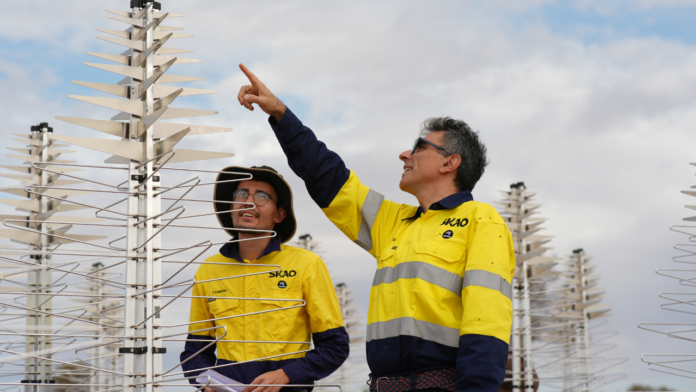The Australian outback, often celebrated for its rugged landscapes and profound solitude, has embarked on a venture that stretches far beyond the confines of our planet. With the inauguration of the first antennas for the SKA-Low radio telescope in Western Australia’s Mid West, humanity edges closer to unlocking the mysteries of the cosmos. This initiative, set on the ancestral lands of the Wajarri Country, marks a pivotal advance in our quest to comprehend the universe’s earliest epochs.
The installation of these Christmas tree-shaped antennas, towering at two meters, signifies the commencement of a global endeavor to construct one of the planet’s most ambitious science facilities. The SKA-Low, in tandem with its counterpart, the SKA-Mid in South Africa, embodies the collaborative spirit of the SKA Observatory (SKAO). This partnership, involving 16 countries, is dedicated to revolutionizing our grasp of the cosmos through unprecedented detail and scope.
According to Prof. Phillip Diamond, SKAO’s Director-General, the placement of the first antennas represents the fruition of decades-long aspirations within the astronomical community. This momentous occasion not only celebrates the realization of this dream but also heralds a new era of scientific discovery. These advanced instruments will challenge existing theories, including those posited by Einstein, and unveil the universe in unparalleled clarity. From witnessing the life cycles of the first stars and galaxies to exploring the universe’s initial billion years post-dark ages, the potential for discovery is boundless.
Dr. Sarah Pearce, the Australia-based Director of the SKA-Low Telescope, emphasized the transformative nature of this project. By likening the telescopes to time machines, she highlighted their capability to offer insights never before accessible to humanity. Their unique design allows for the mapping of the sky at speeds over a hundred times faster than current leading telescopes. Moreover, their sensitivity enables the detection of the faintest radio signals, which have traversed billions of light years to reach us.
The collaboration with Australia’s national science agency, CSIRO, underscores the project’s emphasis on partnership and innovation. This week also marked the beginning of a significant phase for the new field technicians, tasked with the construction of over 130,000 antennas. Notably, the inclusion of seven Wajarri community members among the technicians reflects a commitment to local engagement and empowerment. This initiative, supported by a 12-month training program, aims not only to build the SKA-Low telescope but also to enhance the long-term employment prospects of the participants.
CSIRO’s Chief Executive, Dr. Doug Hilton, described the SKA project as heralding a new scientific age of wonder. By promising discoveries that will extend our understanding of the universe, the project also stands as a testament to the power of collaboration. This spirit is vividly illustrated in the partnership with the Wajarri Yamaji People, the traditional owners of the observatory site. This collaboration seeks not only to advance scientific inquiry but also to honor and integrate the profound knowledge and wisdom of the Wajarri Yamaji People.
Jamie Strickland, CEO of the Wajarri Yamaji Aboriginal Corporation, expressed pride in this significant milestone for the SKA project. He highlighted the project’s role in fostering opportunities for the Wajarri Yamaji People to engage in managing their heritage and culture actively. Furthermore, the project’s emphasis on economic development and employment opportunities was noted as a boon for the community. This engagement places the Wajarri Yamaji People prominently on the global stage, showcasing how traditional knowledge can inform contemporary technology and deepen our understanding of the universe.
As the SKA project progresses, with completion expected by the end of the decade, it stands as a beacon of international cooperation, scientific advancement, and cultural respect. The project not only promises to expand our cosmic knowledge but also to foster a shared understanding and appreciation of the universe’s wonders. In the words of Prof. Diamond, sharing the skies and stars with the Wajarri Yamaji People is not just an endeavor of scientific inquiry but a privilege that honors a tradition of celestial observation that spans tens of thousands of years. This initiative, therefore, represents not just a leap forward in technological achievement but a profound connection between past, present, and future explorations of the cosmos.


